Class 10 Exam > Class 10 Notes > Biology for GCSE/IGCSE > Tropisms
Tropisms | Biology for GCSE/IGCSE - Class 10 PDF Download
Gravitropism & Phototropism
Tropisms
- Plants have the ability to react to changes in their environment, such as light, water, and gravity, in order to survive.
- Unlike animals, plant responses to stimuli are generally slower.
- Plants exhibit tropisms, where they either grow towards a stimulus (positive response) or away from it (negative response).
- These directional growth responses in plants are known as tropisms.
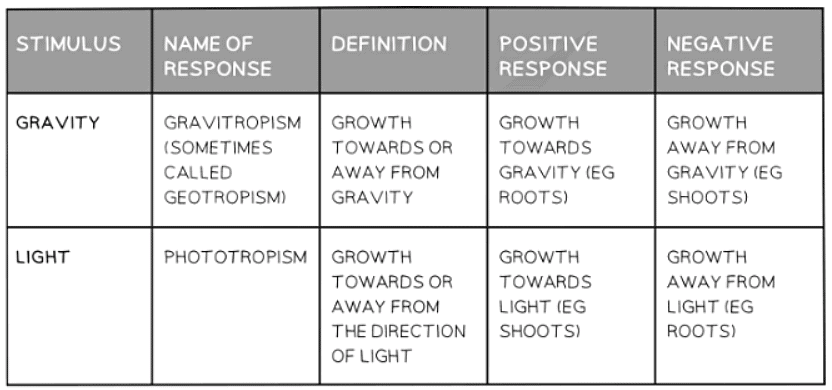
- The proper growth direction of roots and shoots is crucial for plant development.
- Shoots exhibit a positive phototropic response, growing upwards towards light, while also showing a negative gravitropic response, moving away from gravity.
- Conversely, roots display a negative phototropic response, growing downwards away from light, and a positive gravitropic response, growing towards gravity to anchor the plant and absorb water and minerals.
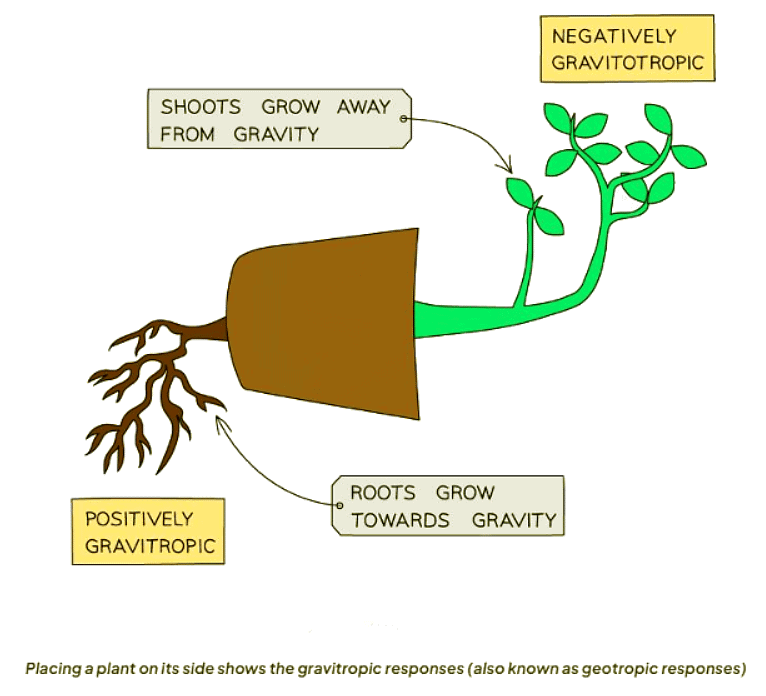
Investigating Tropisms
Investigating Phototropisms
- Three identical plants are set up as shown below (A, B and C)
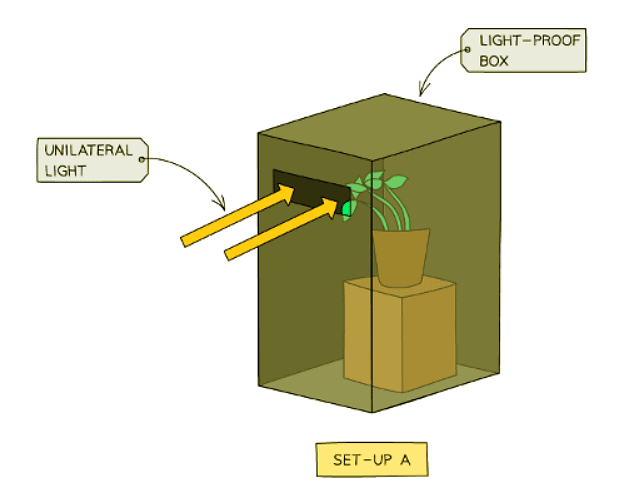
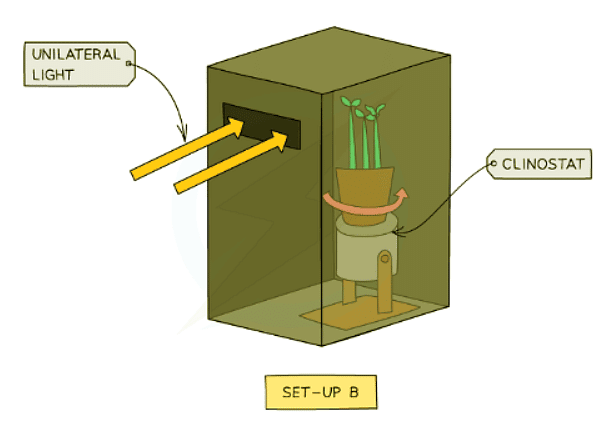
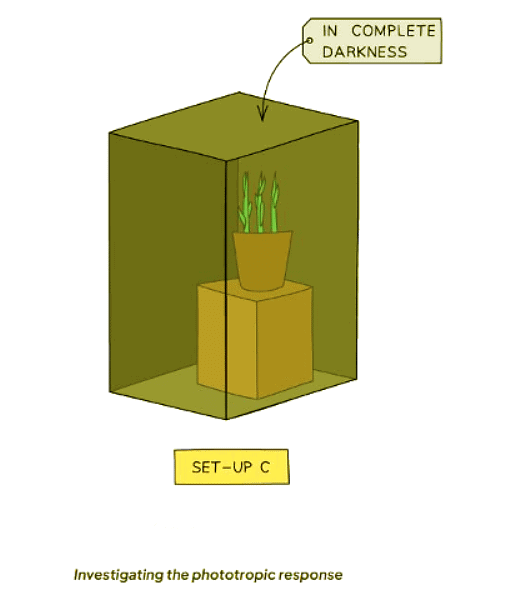
- Seedlings in setup A exhibit positive phototropism, growing towards the light source.
- In setup B, the clinostat negates the directional effect of light, resulting in seedlings growing straight up without curving towards the light.
- Seedlings in setup C grow straight up in search of light, leading to tall, slender plants with yellowing leaves due to light deprivation.
Investigating Gravitropisms
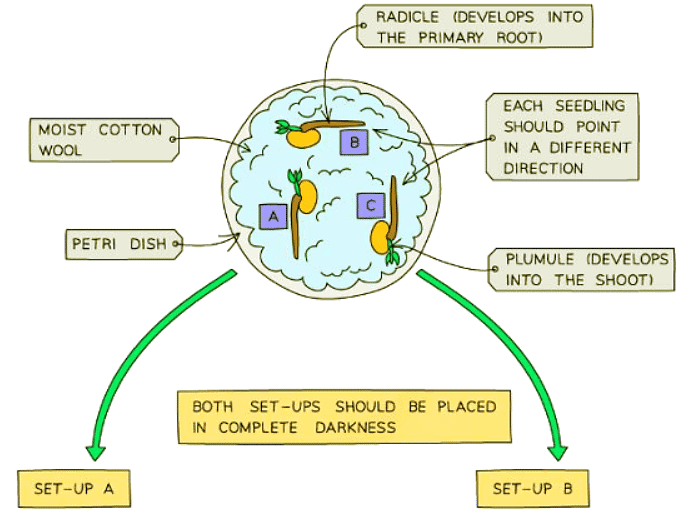
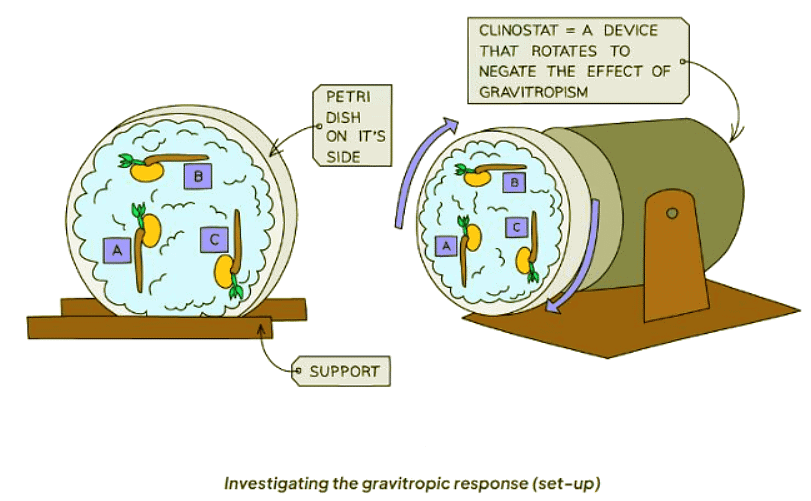
Key Points:
- Add moist cotton wool to two separate petri dishes.
- Introduce three bean seedlings into the cotton wool within each petri dish:
- Seedling A: Position the radicle (embryonic root) facing downwards.
- Seedling B: Place horizontally.
- Seedling C: Direct the radicle upwards.
- Secure each dish with a lid.
- Fix one petri dish horizontally to a support.
- Attach the second petri dish to a clinostat for controlled rotation.
- Position both dishes in a light-proof enclosure for two days to observe growth.
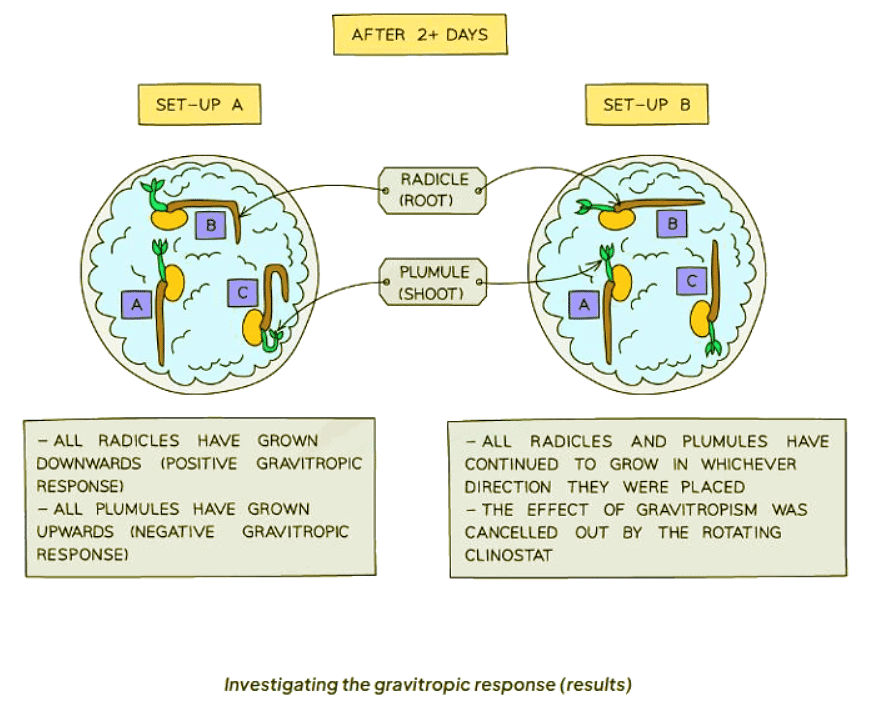
- In the first petri dish, radicles exhibit positive gravitropic response by growing downwards, while plumules show negative gravitropic response by growing upwards, regardless of their initial orientation.
- In the second petri dish, the clinostat nullifies the effect of gravity, causing both radicles and plumules to grow straight outwards without any gravitropic response.
- To isolate the effect of gravity, the experiment should be conducted in a lightproof box to eliminate any influence of light on seedling growth.
Question for TropismsTry yourself: What is the purpose of investigating tropisms in plants?View Solution
Auxins: Chemical Control of Tropisms
- Plants respond to external influences by releasing a growth hormone known as auxin, which dictates the orientation of root and stem growth.
- Plants react to external stimuli by secreting a that regulates the direction of root or stem growth.
- Consequently, we can assert that plants regulate their growth through chemical means.
- As a result, it can be inferred that plants manage their growth
- Auxin is predominantly synthesized in the tips of actively growing roots and stems. It can migrate to other regions of these structures, diffusing from areas of high concentration at the tips towards regions of lower concentration.
- Most of the auxin is produced in the of actively growing roots and stems and can spread to other parts of these structures; moving from regions of high concentration at the tips towards regions of lower concentration.
- Auxin prompts the elongation of cells situated behind the tip; the greater the concentration of auxin, the more rapid the elongation and growth process. It is crucial to note that only the area behind the shoot tip is capable of fostering growth through cell division and elongation. This particular section of a shoot is referred to as the meristem.
- Auxin stimulates the cells positioned behind the tip (to increase in size); the higher the concentration of auxin, the quicker the elongation and growth process.
- When light surrounds the shoot uniformly, auxin disperses evenly throughout, causing cells in the meristem to grow at a consistent rate. This scenario mirrors the typical growth pattern of plants in outdoor settings.
- In situations where light encompasses the shoot from all directions, auxin is evenly distributed throughout, resulting in cells in the meristem growing uniformly. This occurrence is typical for plants growing in outdoor environments.
- In contrast, when light predominantly strikes the shoot from one side, auxin production in the tip becomes concentrated on the shaded side. Consequently, cells on this side experience accelerated elongation and growth compared to cells on the sunlit side. This uneven growth pattern leads to the bending and growth of the shoot towards the source of light.
- Conversely, if light primarily shines on one side of the shoot, auxin production in the tip becomes concentrated on the shaded side. As a result, cells on this side elongate and grow at a faster pace than cells on the sunny side. This disparate growth on either side of the shoot causes it to bend and grow towards the light source.
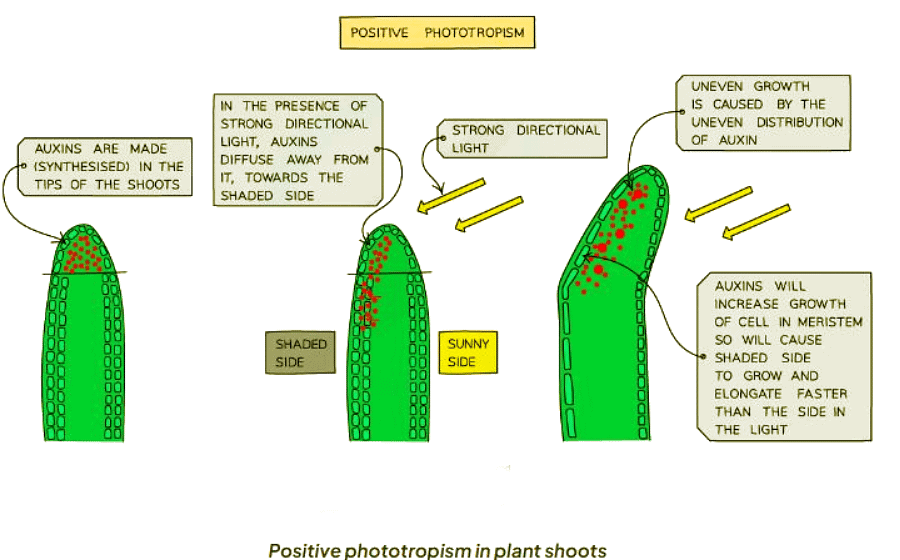
The role of auxin can be tested by placing seedlings in a box with a slit on one side, permitting light to enter from only one direction.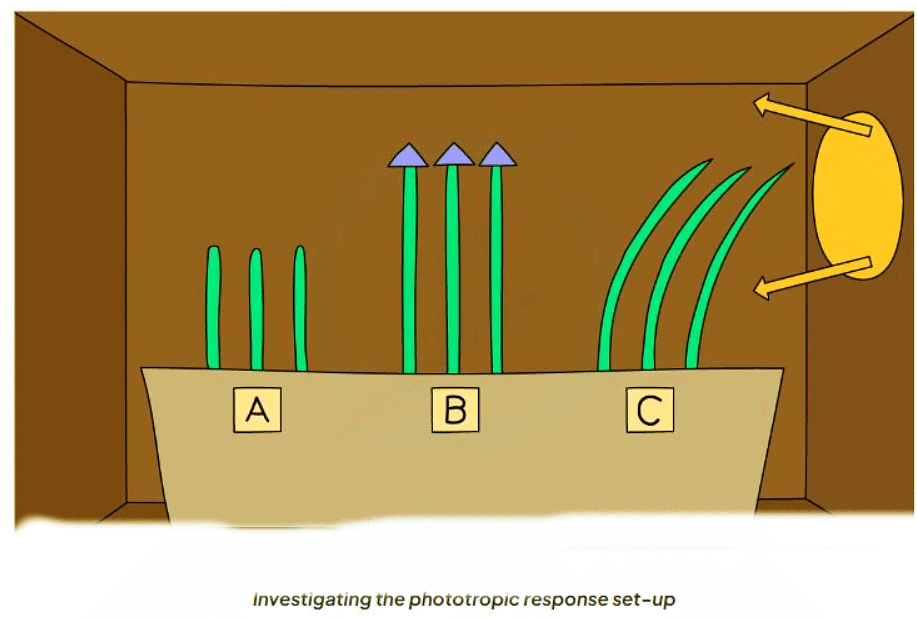
Investigating the phototropic response results:
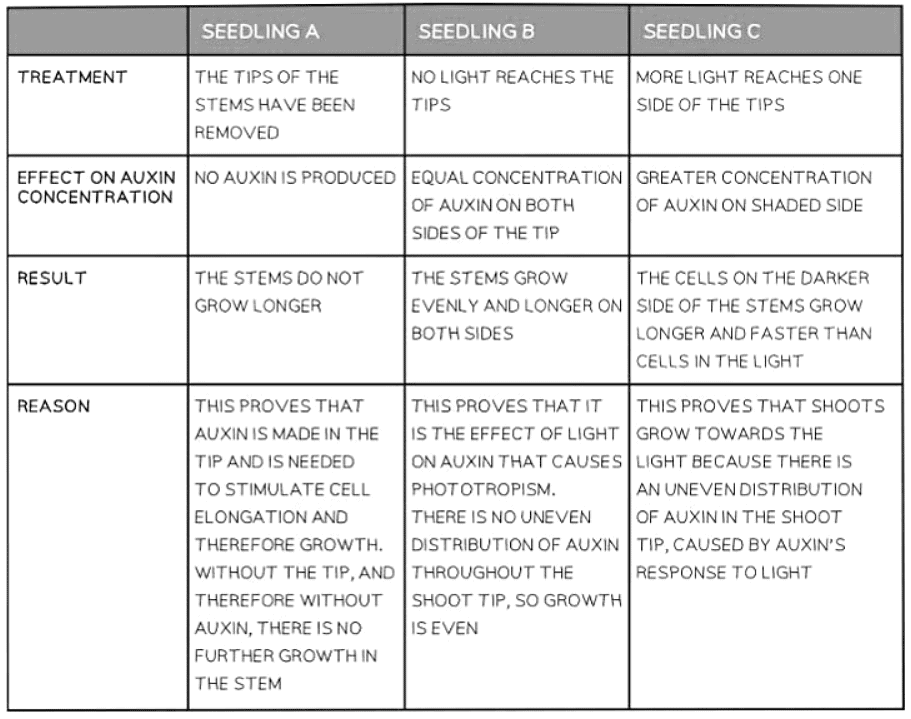
- Auxin influences a plant's response to gravity, affecting shoots and roots differently.
- When shoots grow away from gravity, it is known as negative geotropism.
- Gravity affects auxin distribution, causing it to accumulate on the lower side of the shoot.
- As observed in the phototropic response, auxin increases the growth rate in shoots, making them grow upwards.
- When roots grow towards gravity, it is known as positive geotropism.
- In roots, higher concentrations of auxin lead to a lower rate of cell elongation.
- Auxin accumulation on the lower side of the root inhibits cell elongation.
- Consequently, the lower side grows slower than the upper side, causing the root to bend downwards.
The document Tropisms | Biology for GCSE/IGCSE - Class 10 is a part of the Class 10 Course Biology for GCSE/IGCSE.
All you need of Class 10 at this link: Class 10
|
101 videos|193 docs|33 tests
|
FAQs on Tropisms - Biology for GCSE/IGCSE - Class 10
| 1. What is gravitropism and how does it affect plant growth? |  |
Ans. Gravitropism is the growth of a plant in response to gravity. Plant roots exhibit positive gravitropism, meaning they grow downward, while plant shoots exhibit negative gravitropism, growing upward against gravity.
| 2. How does phototropism allow plants to respond to light? |  |
Ans. Phototropism is the growth of a plant in response to light. Plant shoots exhibit positive phototropism, growing towards light, while plant roots exhibit negative phototropism, growing away from light.
| 3. How do auxins play a role in controlling tropisms in plants? |  |
Ans. Auxins are plant hormones that regulate plant growth and development, including tropisms. They help to control the direction of plant growth in response to stimuli such as gravity and light.
| 4. What are some common examples of plants exhibiting tropisms in nature? |  |
Ans. Some common examples of plants exhibiting tropisms include sunflowers turning their heads to face the sun (phototropism) and roots growing downwards into the soil (gravitropism).
| 5. How can scientists study tropisms in plants to better understand their growth patterns? |  |
Ans. Scientists can study tropisms in plants by conducting experiments where they manipulate the direction of gravity or light exposure to observe how plants respond. This can help them gain insights into the mechanisms behind plant growth and development.
Related Searches




















